
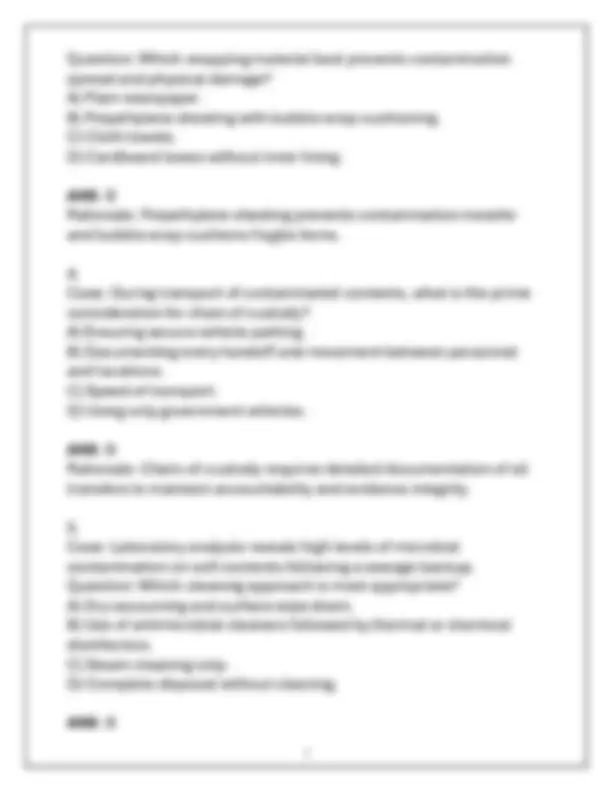
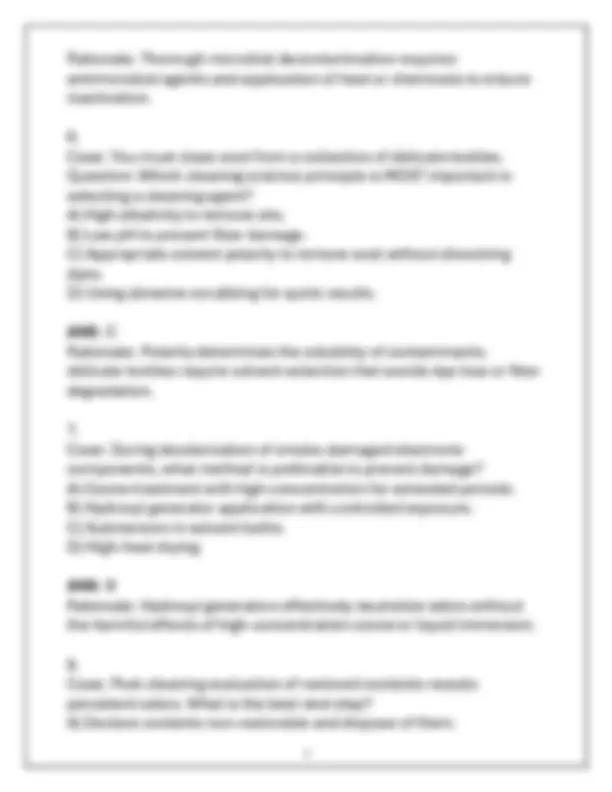
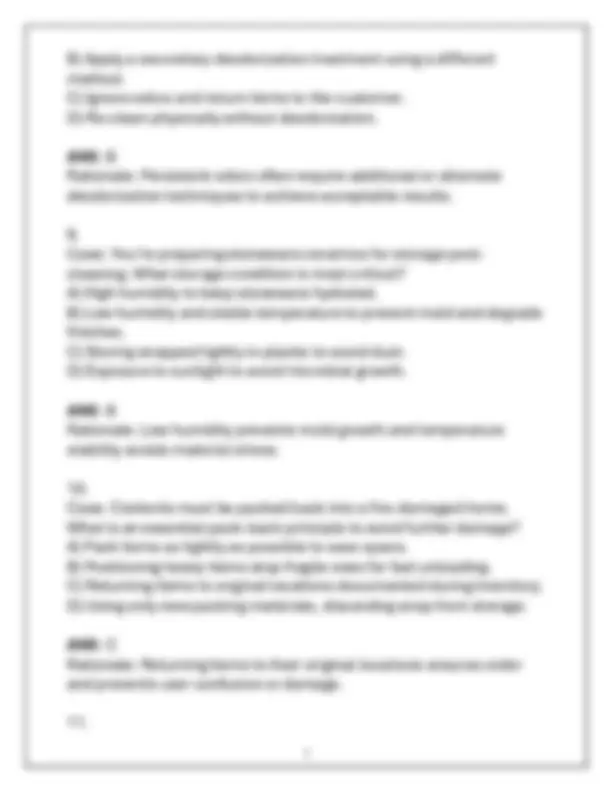
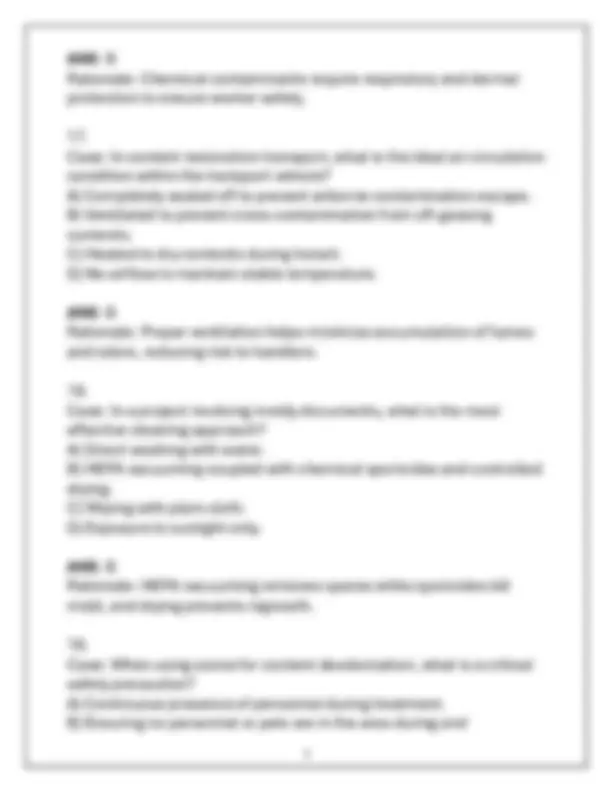
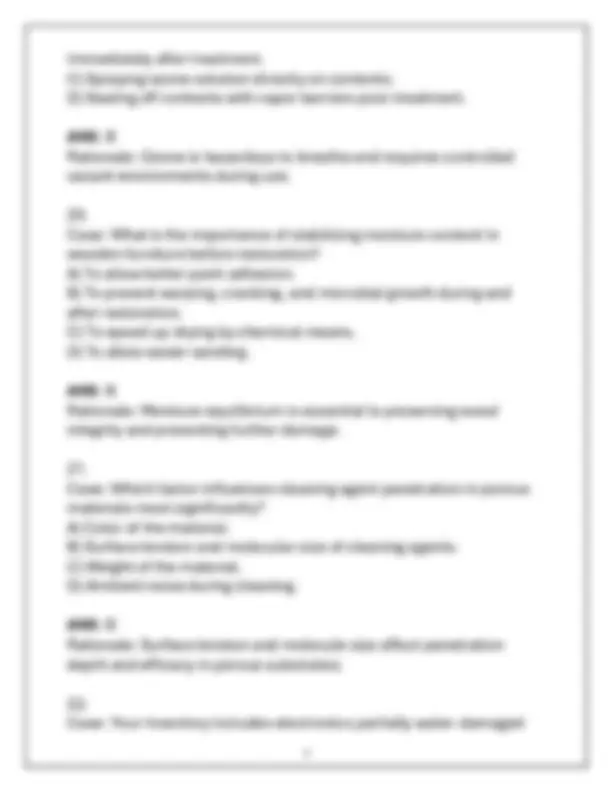
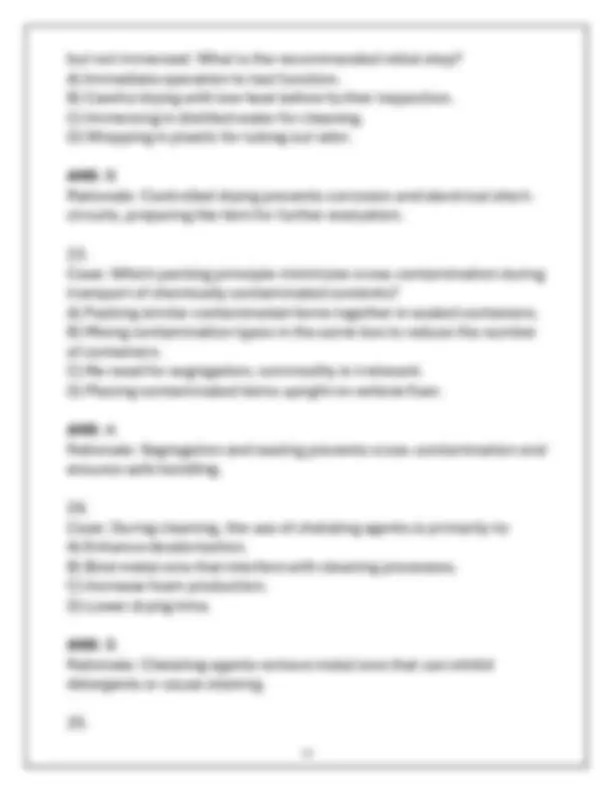
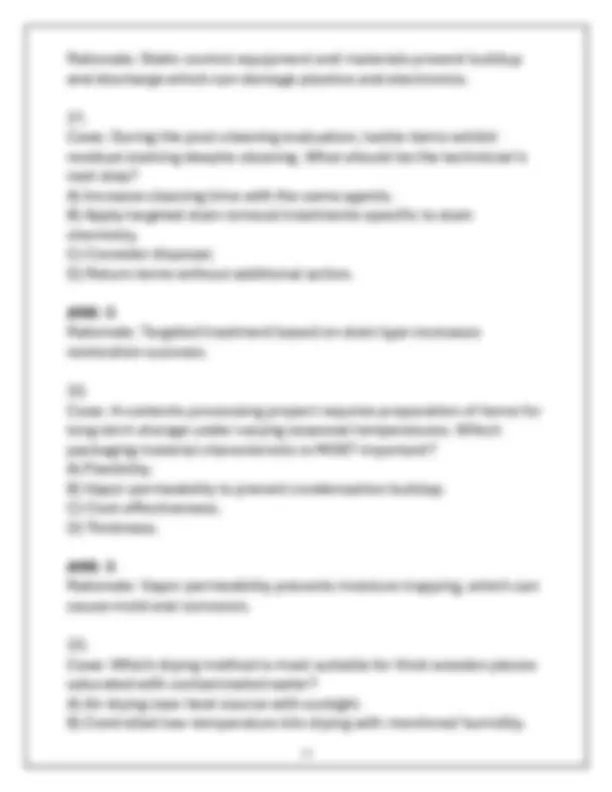
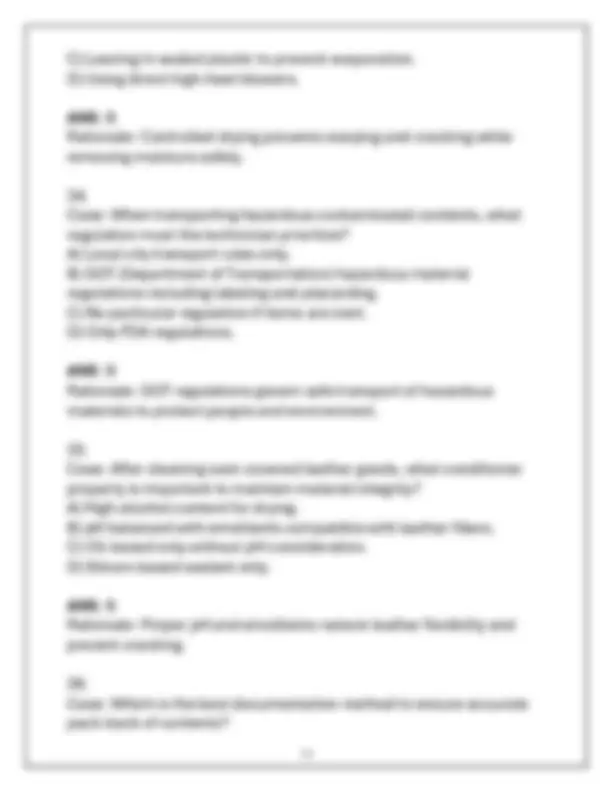
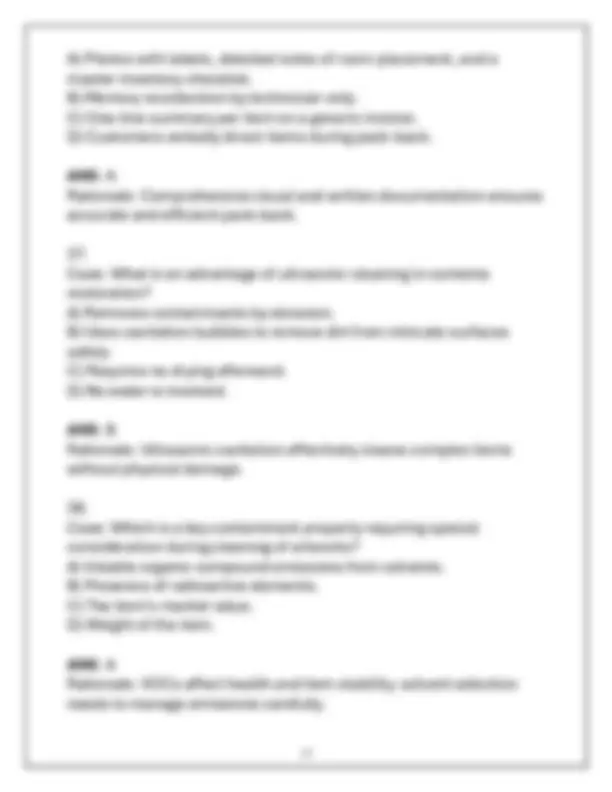
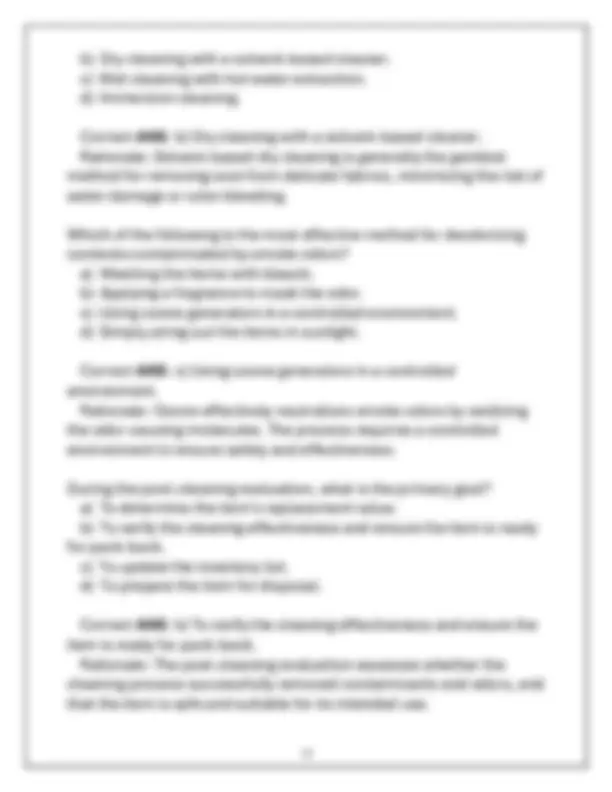
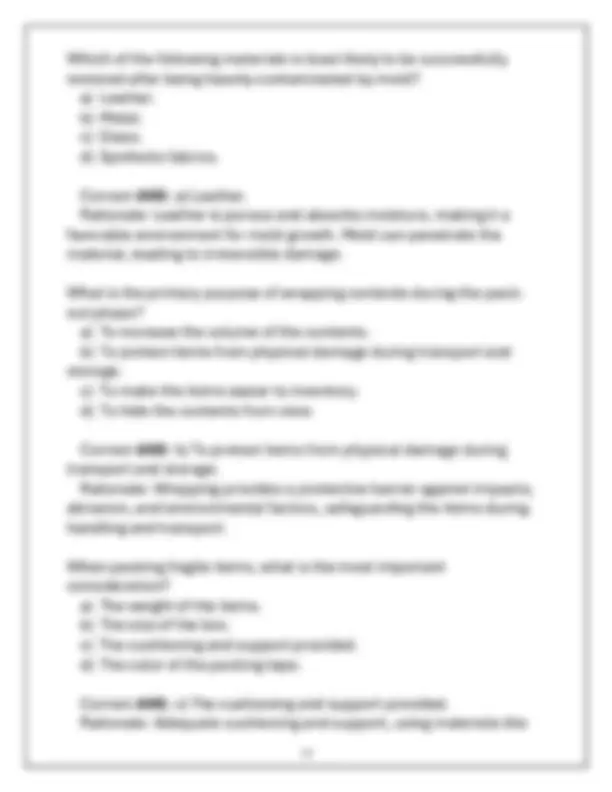
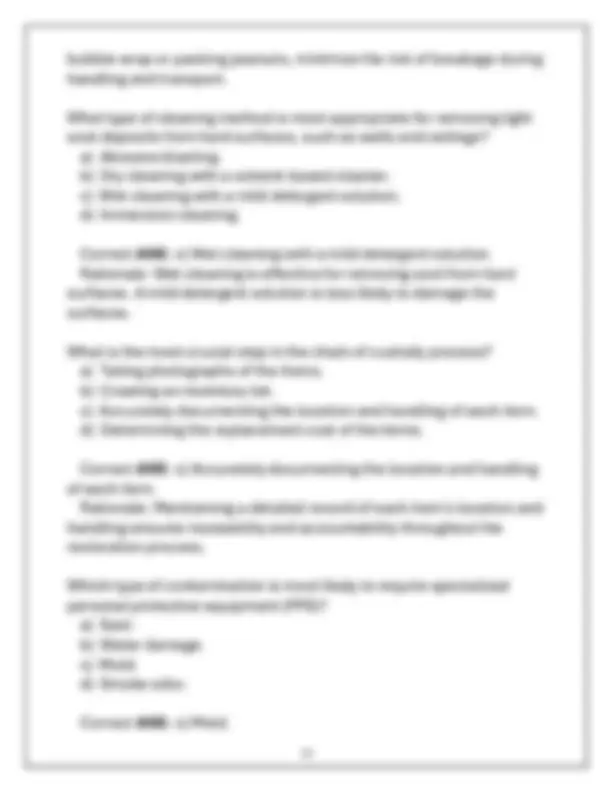
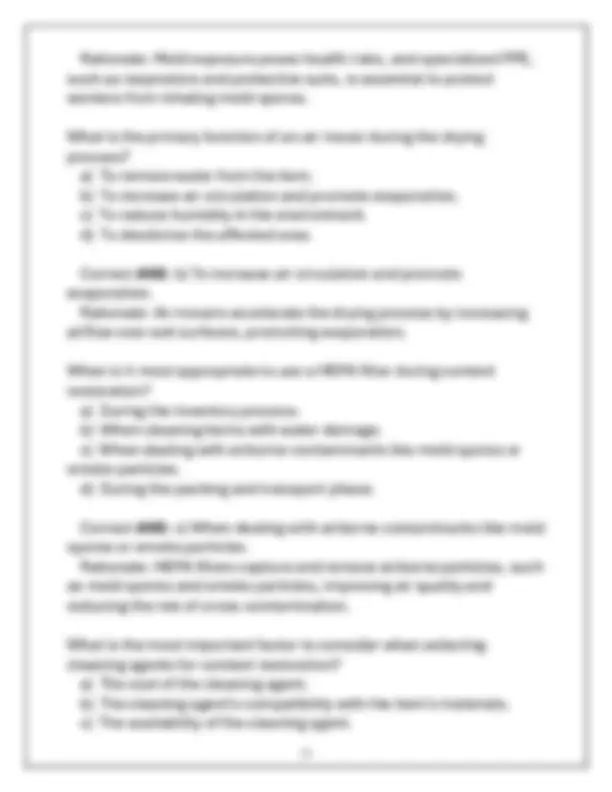
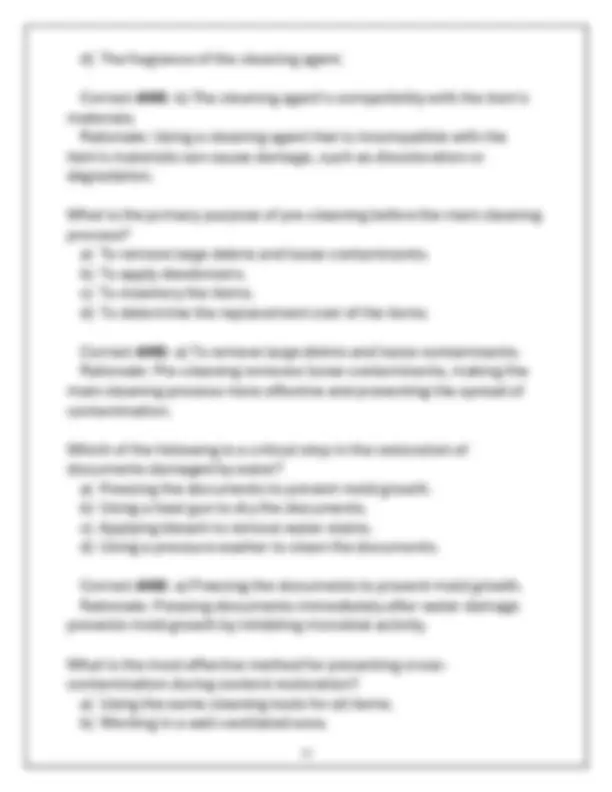
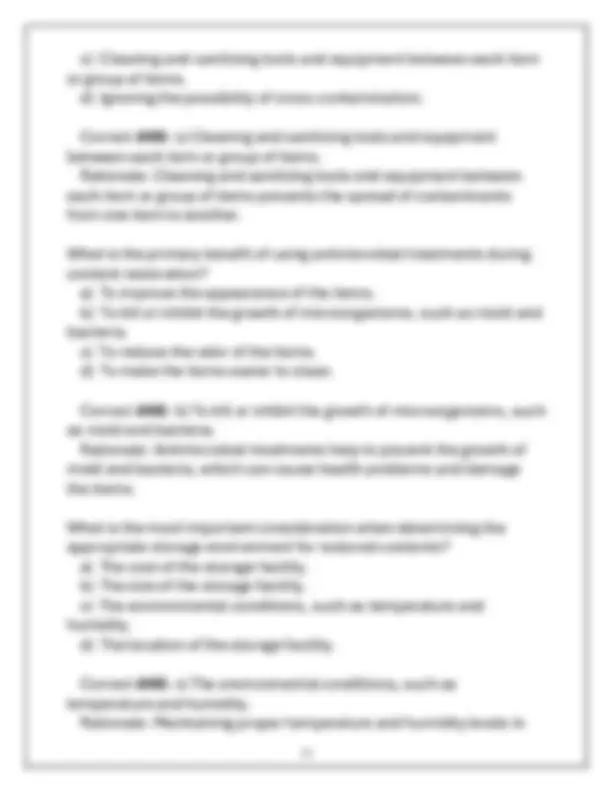
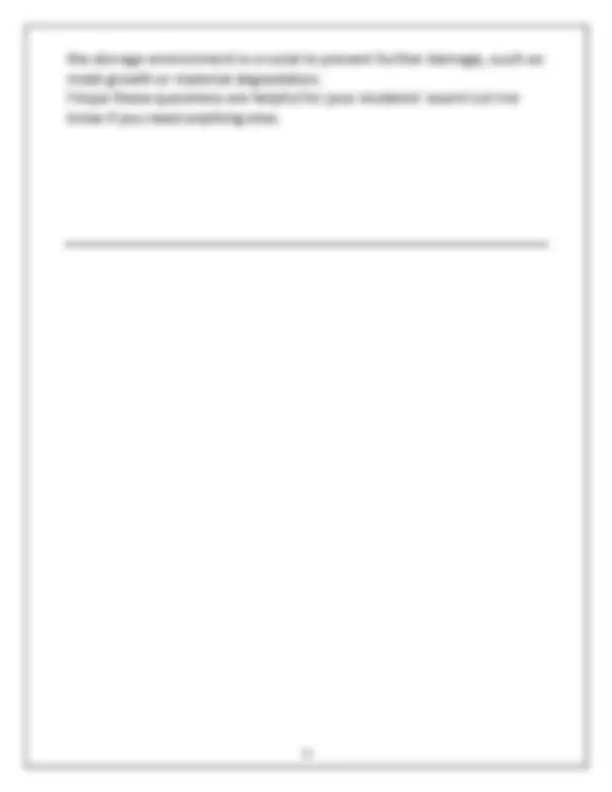


Study with the several resources on Docsity

Earn points by helping other students or get them with a premium plan


Prepare for your exams
Study with the several resources on Docsity

Earn points to download
Earn points by helping other students or get them with a premium plan
Community
Ask the community for help and clear up your study doubts
Discover the best universities in your country according to Docsity users
Free resources
Download our free guides on studying techniques, anxiety management strategies, and thesis advice from Docsity tutors
This assessment reviews contents processing for fire and flood-damaged residences, covering soot inspection, water-damaged furniture inventory, and contaminated item handling. It addresses chain of custody, microbial decontamination, cleaning agent selection for textiles, and smoke deodorization of electronics. Emphasis is placed on moisture stabilization in wooden furniture and thermal imaging for water damage detection. Rationales provide insights into content restoration, covering packing, critical micelle concentration (cmc), and PPE for chemical contamination. It concludes with air circulation during transport and moldy document cleaning.
Typology: Exams
1 / 24

This page cannot be seen from the preview
Don't miss anything!

















Case: A fire-damaged residence contains various soot-encrusted household items. You are assigned to inspect and inventory the contents. Question: Which is the most critical first step in inspecting soot- contaminated contents? A) Using dry brushing to remove surface soot before inventorying. B) Conducting a moisture content test before inventorying. C) Assessing the type of soot (wet vs. dry) and contamination level before inventorying. D) Wrapping contents immediately to prevent further contamination. ANS : C Rationale: Identifying the soot type and contamination level influences cleaning methods and packaging decisions. Inspection precedes any physical cleaning or wrapping.
Case: After a flood, wooden furniture has absorbed contaminated water. Question: What is the best method to inventory such contents? A) Inventory by weight only to save time. B) Note condition, moisture content, contamination type, and assign restoration potential. C) Packing immediately for offsite treatment without documentation. D) Inventory only items that appear dry to minimize work. ANS : B Rationale: Comprehensive documentation of condition and contamination helps determine appropriate restoration methods.
Case: You are preparing to wrap soot-contaminated books for transport.
Rationale: Thorough microbial decontamination requires antimicrobial agents and application of heat or chemicals to ensure inactivation.
Case: You must clean soot from a collection of delicate textiles. Question: Which cleaning science principle is MOST important in selecting a cleaning agent? A) High alkalinity to remove oils. B) Low pH to prevent fiber damage. C) Appropriate solvent polarity to remove soot without dissolving dyes. D) Using abrasive scrubbing for quick results. ANS : C Rationale: Polarity determines the solubility of contaminants; delicate textiles require solvent selection that avoids dye loss or fiber degradation.
Case: During deodorization of smoke-damaged electronic components, what method is preferable to prevent damage? A) Ozone treatment with high concentration for extended periods. B) Hydroxyl generator application with controlled exposure. C) Submersion in solvent baths. D) High-heat drying. ANS : B Rationale: Hydroxyl generators effectively neutralize odors without the harmful effects of high-concentration ozone or liquid immersion.
Case: Post-cleaning evaluation of restored contents reveals persistent odors. What is the best next step? A) Declare contents non-restorable and dispose of them.
B) Apply a secondary deodorization treatment using a different method. C) Ignore odors and return items to the customer. D) Re-clean physically without deodorization. ANS : B Rationale: Persistent odors often require additional or alternate deodorization techniques to achieve acceptable results.
Case: You’re preparing stoneware ceramics for storage post- cleaning. What storage condition is most critical? A) High humidity to keep stoneware hydrated. B) Low humidity and stable temperature to prevent mold and degrade finishes. C) Storing wrapped tightly in plastic to avoid dust. D) Exposure to sunlight to avoid microbial growth. ANS : B Rationale: Low humidity prevents mold growth and temperature stability avoids material stress.
Case: Contents must be packed back into a fire-damaged home. What is an essential pack-back principle to avoid further damage? A) Pack items as tightly as possible to save space. B) Positioning heavy items atop fragile ones for fast unloading. C) Returning items to original locations documented during inventory. D) Using only new packing materials, discarding wrap from storage. ANS : C Rationale: Returning items to their original locations ensures order and prevents user confusion or damage.
Case: A spray fire has produced oily soot on metal items. Which cleaning agent type is preferred? A) Water-based detergent only. B) Solvent-based cleaner targeted at oils and hydrocarbons. C) Abrasive powders. D) Plain water rinse. ANS : B Rationale: Solvent-based cleaners dissolve oily residues better than water-based options.
Case: How does the Critical Micelle Concentration (CMC) principle aid cleaning process selection? A) It determines the temperature at which detergents degrade. B) It identifies the concentration where surfactants most efficiently capture contaminants. C) It measures pH of the cleaning solution. D) It predicts corrosion potential. ANS : B Rationale: At CMC, surfactants form micelles, which encapsulate and remove dirt/oil effectively.
Case: During packing, which PPE item is a MUST for technicians handling chemically contaminated items? A) Leather gloves only. B) Respirator compatible with chemical vapors and gloves impervious to chemicals. C) Cotton gloves only. D) No PPE if items are dry.
Rationale: Chemical contaminants require respiratory and dermal protection to ensure worker safety.
Case: In content restoration transport, what is the ideal air circulation condition within the transport vehicle? A) Completely sealed off to prevent airborne contamination escape. B) Ventilated to prevent cross-contamination from off-gassing contents. C) Heated to dry contents during transit. D) No airflow to maintain stable temperature. ANS : B Rationale: Proper ventilation helps minimize accumulation of fumes and odors, reducing risk to handlers.
Case: In a project involving moldy documents, what is the most effective cleaning approach? A) Direct washing with water. B) HEPA vacuuming coupled with chemical sporicides and controlled drying. C) Wiping with plain cloth. D) Exposure to sunlight only. ANS : B Rationale: HEPA vacuuming removes spores while sporicides kill mold, and drying prevents regrowth.
Case: When using ozone for content deodorization, what is a critical safety precaution? A) Continuous presence of personnel during treatment. B) Ensuring no personnel or pets are in the area during and
but not immersed. What is the recommended initial step? A) Immediate operation to test function. B) Careful drying with low heat before further inspection. C) Immersing in distilled water for cleaning. D) Wrapping in plastic for tubing out odor. ANS : B Rationale: Controlled drying prevents corrosion and electrical short- circuits, preparing the item for further evaluation.
Case: Which packing principle minimizes cross-contamination during transport of chemically contaminated contents? A) Packing similar contaminated items together in sealed containers. B) Mixing contamination types in the same box to reduce the number of containers. C) No need for segregation; commodity is irrelevant. D) Placing contaminated items upright on vehicle floor. ANS : A Rationale: Segregation and sealing prevents cross-contamination and ensures safe handling.
Case: During cleaning, the use of chelating agents is primarily to: A) Enhance deodorization. B) Bind metal ions that interfere with cleaning processes. C) Increase foam production. D) Lower drying time. ANS : B Rationale: Chelating agents remove metal ions that can inhibit detergents or cause staining.
Case: What is the MOST effective post-cleaning evaluation method for confirming deodorization success? A) Subjective human smell assessment only. B) Using electronic odor sensors combined with human assessment. C) Ignoring odors if cleaning appears visually successful. D) Leaving items in sunlight for 48 hours. ANS : B Rationale: Electronic sensors complement human senses and can detect residual odors quantitatively.
Case: An advanced packing protocol for fragile glass items includes: A) Individually wrapping in acid-free tissue, with cushioning and secured in labeled cushioned boxes. B) Using newspaper as wrapping to save cost. C) Packing items tightly to avoid movement. D) Using plastic wrap directly on glass surface. ANS : A Rationale: Acid-free tissue prevents chemical damage; cushioning and labeling protect items physically and logistically.
Case: What is the role of pH in selecting a cleaning solution for soot? A) Neutral pH cleans best regardless of soot type. B) Alkaline solutions are generally better for oily, protein-based soot, acidic for other types. C) Acidic pH accelerates drying of contents. D) pH has no effect on cleaning outcomes. ANS : B Rationale: Different soot chemistries respond better to specific pH ranges for effective removal.
Rationale: Static control equipment and materials prevent buildup and discharge which can damage plastics and electronics.
Case: During the post-cleaning evaluation, textile items exhibit residual staining despite cleaning. What should be the technician’s next step? A) Increase cleaning time with the same agents. B) Apply targeted stain removal treatments specific to stain chemistry. C) Consider disposal. D) Return items without additional action. ANS : B Rationale: Targeted treatment based on stain type increases restoration success.
Case: A contents processing project requires preparation of items for long-term storage under varying seasonal temperatures. Which packaging material characteristic is MOST important? A) Flexibility. B) Vapor permeability to prevent condensation buildup. C) Cost-effectiveness. D) Thickness. ANS : B Rationale: Vapor permeability prevents moisture trapping, which can cause mold and corrosion.
Case: Which drying method is most suitable for thick wooden pieces saturated with contaminated water? A) Air drying near heat source with sunlight. B) Controlled low-temperature kiln drying with monitored humidity.
C) Leaving in sealed plastic to prevent evaporation. D) Using direct high-heat blowers. ANS : B Rationale: Controlled drying prevents warping and cracking while removing moisture safely.
Case: When transporting hazardous contaminated contents, what regulation must the technician prioritize? A) Local city transport rules only. B) DOT (Department of Transportation) hazardous material regulations including labeling and placarding. C) No particular regulation if items are inert. D) Only FDA regulations. ANS : B Rationale: DOT regulations govern safe transport of hazardous materials to protect people and environment.
Case: After cleaning soot-covered leather goods, what conditioner property is important to maintain material integrity? A) High alcohol content for drying. B) pH balanced with emollients compatible with leather fibers. C) Oil-based only without pH consideration. D) Silicon-based sealant only. ANS : B Rationale: Proper pH and emollients restore leather flexibility and prevent cracking.
Case: Which is the best documentation method to ensure accurate pack-back of contents?
Case: During storage, how often should restored contents be inspected for damage or deterioration? A) Once before storage only. B) Periodically, at least quarterly, with condition notes and environmental monitoring. C) Only if complaints arise. D) Weekly for all items regardless of type. ANS : B Rationale: Regular inspection detects issues early, preventing loss and planning maintenance.
Case: What is the primary benefit of using RFID tagging in a contents restoration inventory system? A) Faster movement of items within storage only. B) Automated, accurate tracking and rapid identification during inspection, packing, and transport. C) It replaces the need for physical inventory. D) Lowers equipment costs. ANS : B Rationale: RFID improves database accuracy and efficiency across multiple process stages. Which of the following is the most significant factor in determining the restoration potential of contents affected by sewage contamination? a) The age of the item. b) The duration of exposure. c) The material composition. d) The initial cost of the item. Correct ANS : b) The duration of exposure.
Rationale: The longer an item is exposed to sewage, the more likely it is that contaminants will penetrate the material, leading to irreversible damage and increased restoration challenges. During the inspection phase of content restoration, what is the primary purpose of pre-testing? a) To determine the market value of the item. b) To identify the source of contamination. c) To assess the cleaning efficacy of a chosen method on a specific material. d) To create an inventory list. Correct ANS : c) To assess the cleaning efficacy of a chosen method on a specific material. Rationale: Pre-testing helps determine the compatibility of cleaning agents and methods with the item's materials, minimizing the risk of damage or ineffective cleaning. When creating an inventory of contents, what is the most crucial element to document to maintain a proper chain of custody? a) The item's original purchase price. b) The location of the item. c) The name of the insurance adjuster. d) The date and time of item's handling and the person who handled it. Correct ANS : d) The date and time of item's handling and the person who handled it. Rationale: Detailed documentation of each step of the item's handling, including who handled it and when, ensures accountability and traceability throughout the restoration process. What type of cleaning method is most appropriate for removing soot from delicate upholstered furniture after a fire? a) Abrasive blasting.
Which of the following materials is least likely to be successfully restored after being heavily contaminated by mold? a) Leather. b) Metal. c) Glass. d) Synthetic fabrics. Correct ANS : a) Leather. Rationale: Leather is porous and absorbs moisture, making it a favorable environment for mold growth. Mold can penetrate the material, leading to irreversible damage. What is the primary purpose of wrapping contents during the pack- out phase? a) To increase the volume of the contents. b) To protect items from physical damage during transport and storage. c) To make the items easier to inventory. d) To hide the contents from view. Correct ANS : b) To protect items from physical damage during transport and storage. Rationale: Wrapping provides a protective barrier against impacts, abrasion, and environmental factors, safeguarding the items during handling and transport. When packing fragile items, what is the most important consideration? a) The weight of the items. b) The size of the box. c) The cushioning and support provided. d) The color of the packing tape. Correct ANS : c) The cushioning and support provided. Rationale: Adequate cushioning and support, using materials like
bubble wrap or packing peanuts, minimize the risk of breakage during handling and transport. What type of cleaning method is most appropriate for removing light soot deposits from hard surfaces, such as walls and ceilings? a) Abrasive blasting. b) Dry cleaning with a solvent-based cleaner. c) Wet cleaning with a mild detergent solution. d) Immersion cleaning. Correct ANS : c) Wet cleaning with a mild detergent solution. Rationale: Wet cleaning is effective for removing soot from hard surfaces. A mild detergent solution is less likely to damage the surfaces. What is the most crucial step in the chain of custody process? a) Taking photographs of the items. b) Creating an inventory list. c) Accurately documenting the location and handling of each item. d) Determining the replacement cost of the items. Correct ANS : c) Accurately documenting the location and handling of each item. Rationale: Maintaining a detailed record of each item's location and handling ensures traceability and accountability throughout the restoration process. Which type of contamination is most likely to require specialized personal protective equipment (PPE)? a) Soot. b) Water damage. c) Mold. d) Smoke odor. Correct ANS : c) Mold.